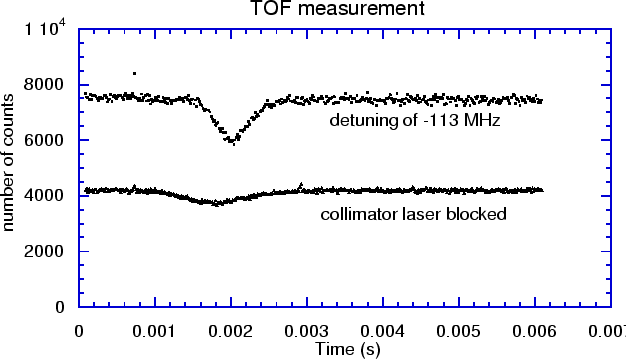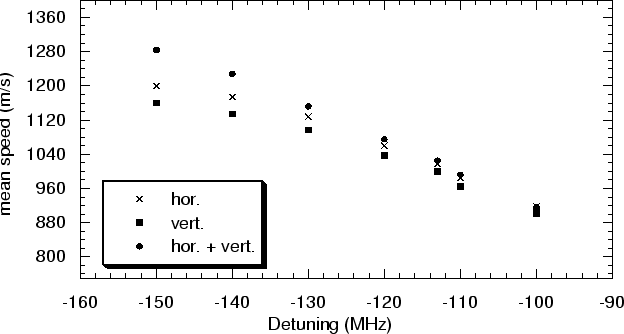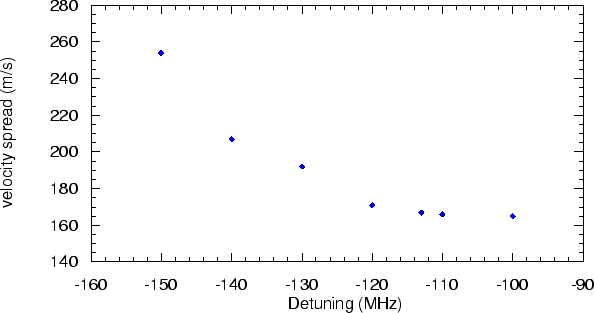 |
We want to see what the effect of the collimator is on the velocity distribution of the metastable He atoms. In fig 3.5 the TOF measurement of the unaltered He* beam is shown together with the measurement of the collimated He* beam. Both of the measurements lasted 5 minutes. It can be seen that the total signal of the collimated beam is about a factor 2 higher than the uncollimated beam. The dip in the collimated beam is much larger, since a much higher percentage of the detected particles is metastable Helium.
Another interesting thing that can be seen from fig 3.5 is that the width of the dip is much smaller for the collimated beam. This can be explained by the fact that the collimator works as a velocity selective device [2]. The angleWe have performed a series of TOF measurements at different detunings of the collimator laser to see what the effect of the collimator is on the velocity distribution of the He* beam. These measurements were done over the frequency range of -150 MHz to -80 MHz. At all detunings we calculated the mean speed of the atoms as well as the velocity spread.
 |
The measurement in which the collimator was working in both
dimensions shows a linear dependency between the detuning and the mean
speed of the collimated He* atoms. With only one dimension of the
collimator working, the increase of the mean speed of the collimated
atoms is smaller at higher detunings. This could be explained by the fact
that for higher detunings a higher velocity is in resonance with the
laser light. These faster atoms have a shorter interaction time with the
laser light in the collimator. This means that the faster atoms are less
effectively collimated, so that the gain of faster atoms is relatively
smaller than for the slower atoms. This results in a lower mean speed
![]() than expected.
than expected.
If we make use of the formula 3.2 and rewrite it
to:
 |
For the situation with two dimensions of the collimator working,
we also looked at the velocity spread of the collimated atoms. The
results can be seen in fig 3.7. The velocity spread is for
all detunings smaller than the velocity
spread of the uncollimated atoms. For detunings further to the red,
the velocity spread is higher, and for detunings closer to resonance
the velocity spread seems to converge to a value of about 160 m/s. An
explanation of this effect could be that the atoms affected by the
lower detunings have a lower speed and therefor a longer interaction
time in the collimator. At higher detunings the atoms are too fast to
stay in resonance with the collimator and there is not a specific
class of velocities that is completely collimated. For the detuning
of -113 MHz, which was the optimal detuning for the collimator, the
spread of the atoms is about 170 m/s, so the atoms can stay in
resonance through the collimator for this detuning.
The converging limit of 160 m/s is caused by the intensity
of the laser light, with a higher ![]() the transition width of the
collimator laser is larger, and a larger class of velocities
can be affected. The width of the transition is given by
Eq. 1.4, with
the transition width of the
collimator laser is larger, and a larger class of velocities
can be affected. The width of the transition is given by
Eq. 1.4, with ![]() (average of
the four laser beams entering the collimator), and
(average of
the four laser beams entering the collimator), and
![]() rad/s. This width of transition will give a range of velocities
rad/s. This width of transition will give a range of velocities
![]() that is affected by the laser light:
that is affected by the laser light: